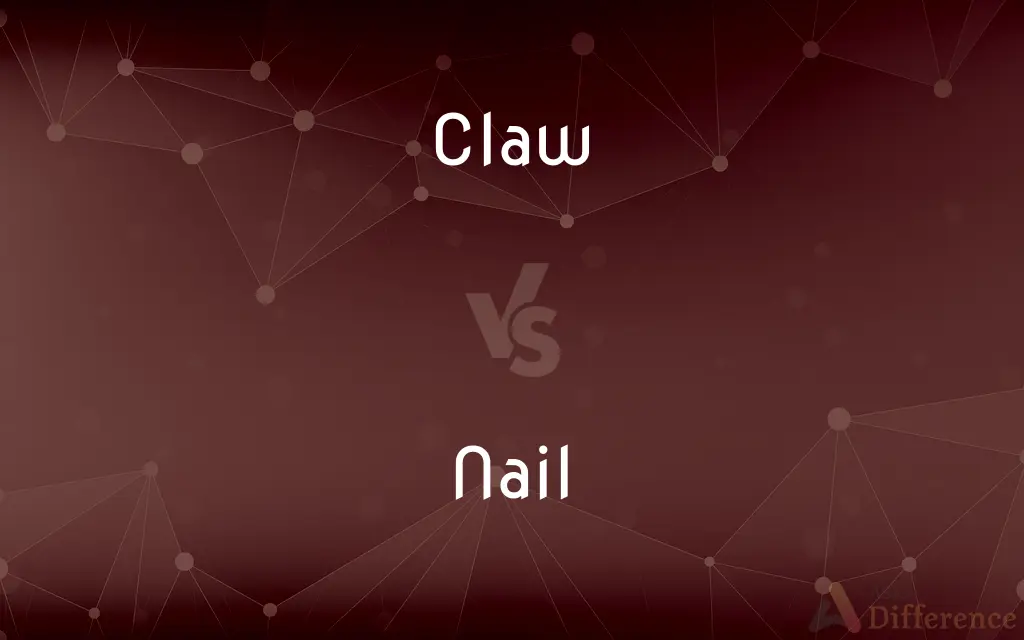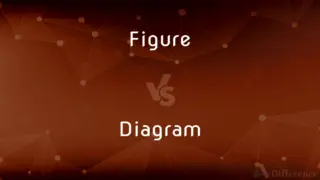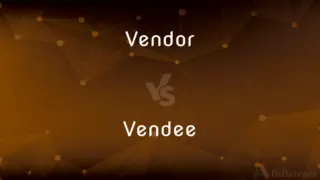Claw vs. Nail — What's the Difference?
By Tayyaba Rehman & Fiza Rafique — Updated on April 29, 2024
Claws are sharp, curved appendages at the ends of the digits of many animals, used for hunting and climbing, whereas nails are flat, protective keratin plates covering the tips of fingers and toes in humans and some primates.

Difference Between Claw and Nail
Table of Contents
ADVERTISEMENT
Key Differences
Claws are typically pointed and curved, serving as tools for gripping, climbing, or as weapons in predatory animals. Whereas nails are generally flat and more rounded, primarily providing structural support and protection to the tips of digits in humans and primates.
In terms of composition, claws are made of a hard protein called keratin and are often much thicker and stronger than nails. On the other hand, nails also consist of keratin but are thinner and serve as a protective cover rather than for active use in catching or defending.
Claws grow continuously and can be sharpened by wear or grooming. Whereas nails also grow continuously but require trimming and do not naturally sharpen.
Animals with claws often use them for hunting, such as cats using their retractable claws to catch prey. Whereas nails are not used for hunting but can be used for tasks requiring fine motor skills, like typing or picking up objects.
Claws are often adapted to an animal's environment or behavior, such as birds having claws for perching. On the other hand, human nails are not significantly adapted for environmental factors but can reflect health conditions or nutritional status.
ADVERTISEMENT
Comparison Chart
Shape
Curved and pointed
Flat and rounded
Composition
Thick, strong keratin
Thinner keratin
Growth
Continuous, self-sharpening
Continuous, requires trimming
Primary Use
Gripping, hunting
Protection, aiding in fine tasks
Adaptation
Environmental and behavioral
Limited, mostly reflects health
Compare with Definitions
Claw
Part of a tool or mechanical device resembling a claw.
The claw of the hammer is used for pulling nails.
Nail
A thin, hard covering at the end of a finger or toe.
She painted her nails a bright red.
Claw
A sharp, curved appendage found at the toe of an animal.
The eagle’s claw is crucial for catching prey.
Nail
An essential or fundamental part of something.
Trust is the nail that holds a relationship together.
Claw
A gripping device in arcade games.
She maneuvered the claw to try and win a stuffed animal.
Nail
A small metal spike with a broadened flat head, driven into wood to join things together.
He used nails to assemble the wooden frame.
Claw
A movable appendage on some insects.
The beetle uses its claw to dig into the bark.
Nail
To complete perfectly.
He nailed the presentation at the meeting today.
Claw
Tines on a fork.
He used the claw of the fork to hold the meat while he cut it.
Nail
To catch someone in the act.
The detective nailed the thief as he was leaving the store.
Claw
A claw is a curved, pointed appendage found at the end of a toe or finger in most amniotes (mammals, reptiles, birds). Some invertebrates such as beetles and spiders have somewhat similar fine, hooked structures at the end of the leg or tarsus for gripping a surface as they walk.
Nail
A slim, pointed piece of metal hammered into material as a fastener.
Claw
A curved pointed horny nail on each digit of the foot in birds, lizards, and some mammals.
Nail
A fingernail or toenail.
Claw
Scratch or tear something with the claws or the fingernails
The kitten was clawing at Lowell's trouser leg
Her hands clawed his shoulders
Nail
A claw or talon.
Claw
(of a sailing ship) beat to windward
The ability to claw off a lee shore
Nail
Something resembling a nail in shape, sharpness, or use.
Claw
A sharp, curved, horny structure at the end of a toe of a vertebrate animal.
Nail
A measure of length formerly used for cloth, equal to 1/16 yard (5.7 centimeters).
Claw
A chela or similar pincerlike structure on the end of a limb of a crustacean or arachnid.
Nail
To fasten, join, or attach with or as if with a nail.
Claw
One of one or more small curved structures at the tip of an appendage of an invertebrate, especially an insect or other arthropod.
Nail
To cover, enclose, or shut by fastening with nails
Nail up a window.
Claw
A limb terminating in such a structure.
Nail
To keep fixed, motionless, or intent
Fear nailed me to my seat.
Claw
Something, such as the cleft end of a hammerhead, that resembles a claw.
Nail
To stop and seize; catch
Police nailed the suspect.
Claw
(Botany) A narrowed, stalklike basal part of a petal, sepal, or bract.
Nail
To detect and expose
Nailed the senator in a lie.
Nail corruption before it gets out of control.
Claw
To scratch, dig, tear, or pull with the claws or fingernails.
Nail
To strike or bring down
Nail a bird in flight.
Nail a running back.
Claw
A curved, pointed horny nail on each digit of the foot of a mammal, reptile, or bird.
Nail
To perform successfully or have noteworthy success in
Nailed the dive.
Nailed the exam.
Claw
A foot equipped with such.
Nail
(Baseball) To put out (a base runner).
Claw
The pincer (chela) of a crustacean or other arthropod.
Nail
Vulgar Slang To have sexual intercourse with.
Claw
A mechanical device resembling a claw, used for gripping or lifting.
Nail
The thin, horny plate at the ends of fingers and toes on humans and some other animals.
When I'm nervous I bite my nails.
Claw
(colloquial) A human fingernail, particularly one extending well beyond the fingertip.
Nail
The basal thickened portion of the anterior wings of certain hemiptera.
Claw
(botany) A slender appendage or process, formed like a claw, such as the base of petals of the pink.
Nail
The terminal horny plate on the beak of ducks, and other allied birds.
Claw
(juggling) The act of catching a ball overhand.
Nail
The claw of a bird or other animal.
Claw
To scratch or to tear at.
Nail
A spike-shaped metal fastener used for joining wood or similar materials. The nail is generally driven through two or more layers of material by means of impacts from a hammer or other device. It is then held in place by friction.
Claw
To use the claws to seize, to grip.
Nail
A round pedestal on which merchants once carried out their business, such as the four nails outside The Exchange, Bristol.
Claw
To use the claws to climb.
Nail
An archaic English unit of length equivalent to 20 of an ell or 16 of a yard (4 inches or 5.715 cm).
Claw
(juggling) To perform a claw catch.
Nail
(transitive) To fix (an object) to another object using a nail.
He nailed the placard to the post.
Claw
To move with one's fingertips.
Nail
(intransitive) To drive a nail.
He used the ax head for nailing.
Claw
To relieve an uneasy feeling, such as an itch, by scratching (someone or something); hence (figuratively), to flatter or humour (someone); to court, to fawn on.
Nail
(transitive) To stud or boss with nails, or as if with nails.
Claw
To rail at, revile, or scold (someone or something).
Nail
(slang) To catch.
Claw
To do (something) quickly.
Nail
To expose as a sham.
Claw
A sharp, hooked nail, as of a beast or bird.
Nail
To accomplish (a task) completely and successfully.
I really nailed that test.
Claw
The whole foot of an animal armed with hooked nails; the pinchers of a lobster, crab, etc.
Nail
To hit (a target) effectively with some weapon.
Claw
Anything resembling the claw of an animal, as the curved and forked end of a hammer for drawing nails.
Nail
Of a male, to engage in sexual intercourse with.
Claw
A slender appendage or process, formed like a claw, as the base of petals of the pink.
Nail
(military) To spike, as a cannon.
Claw
To pull, tear, or scratch with, or as with, claws or nails.
Nail
(transitive) To nail down: to make certain, or confirm.
Claw
To relieve from some uneasy sensation, as by scratching; to tickle; hence, to flatter; to court.
Rich men they claw, soothe up, and flatter; the poor they contemn and despise.
Nail
The horny scale of plate of epidermis at the end of the fingers and toes of man and many apes.
His nayles like a briddes claws were.
Claw
To rail at; to scold.
In the aforesaid preamble, the king fairly claweth the great monasteries, wherein, saith he, religion, thanks be to God, is right well kept and observed; though he claweth them soon after in another acceptation.
Nail
The basal thickened portion of the anterior wings of certain hemiptera.
Claw
To scrape, scratch, or dig with a claw, or with the hand as a claw.
Nail
A slender, pointed piece of metal, usually with a head{2}, used for fastening pieces of wood or other material together, by being driven into or through them.
Claw
Sharp curved horny process on the toe of a bird or some mammals or reptiles
Nail
A measure of length, being two inches and a quarter, or the sixteenth of a yard.
Claw
A mechanical device that is curved or bent to suspend or hold or pull something
Nail
To fasten with a nail or nails; to close up or secure by means of nails; as, to nail boards to the beams.
He is now dead, and nailed in his chest.
Claw
A structure like a pincer on the limb of a crustacean or other arthropods
Nail
To stud or boss with nails, or as with nails.
The rivets of your arms were nailed with gold.
Claw
A bird's foot that has claws
Nail
To fasten, as with a nail; to bind or hold, as to a bargain or to acquiescence in an argument or assertion; hence, to catch; to trap.
When they came to talk of places in town, you saw at once how I nailed them.
Claw
Move as if by clawing, seizing, or digging;
They clawed their way to the top of the mountain
Nail
To spike, as a cannon.
Claw
Clutch as if in panic;
She clawed the doorknob
Nail
Horny plate covering and protecting part of the dorsal surface of the digits
Claw
Scratch, scrape, pull, or dig with claws or nails
Nail
A thin pointed piece of metal that is hammered into materials as a fastener
Claw
Attack as if with claws;
The politician clawed his rival
Nail
A former unit of length for cloth equal to 1/16 of a yard
Nail
Attach something somewhere by means of nails;
Nail the board onto the wall
Nail
Take into custody;
The police nabbed the suspected criminals
Nail
Hit hard;
He smashed a 3-run homer
Nail
Succeed in obtaining a position;
He nailed down a spot at Harvard
Nail
Succeed at easily;
She sailed through her exams
You will pass with flying colors
She nailed her astrophysics course
Nail
Locate exactly;
Can you pinpoint the position of the enemy?
The chemists could not nail the identity of the chromosome
Nail
Complete a pass
Common Curiosities
What animals are known for their claws?
Cats, birds of prey, and bears are well-known for their distinctive claws.
Do all animals have claws?
No, not all animals have claws; some have hooves or other types of digits.
Can nails indicate diseases?
Yes, changes in nail color, texture, or growth can indicate health issues.
What is the primary function of a claw?
Claws are primarily used for hunting and gripping.
Why do humans have nails?
Human nails provide protection for the fingertips and enhance the ability to pick up objects.
Do any animals have both claws and nails?
Some primates have nail-like structures on most digits and more claw-like structures on others.
Can nails be used for defense?
Nails are not typically used for defense but can be used incidentally for scratching.
How do claws differ from talons?
Talons are a type of claw specifically adapted for catching and holding prey, mostly found in birds of prey.
Are nails important for health?
Yes, the condition of nails can reflect overall health and nutritional status.
Do claws require maintenance?
Yes, animals often need to groom their claws, depending on their lifestyle.
How do primates use their nails?
Primates use their nails for grooming, manipulating objects, and climbing.
Share Your Discovery

Previous Comparison
Figure vs. Diagram
Next Comparison
Vendor vs. VendeeAuthor Spotlight
Written by
Tayyaba RehmanTayyaba Rehman is a distinguished writer, currently serving as a primary contributor to askdifference.com. As a researcher in semantics and etymology, Tayyaba's passion for the complexity of languages and their distinctions has found a perfect home on the platform. Tayyaba delves into the intricacies of language, distinguishing between commonly confused words and phrases, thereby providing clarity for readers worldwide.
Co-written by
Fiza RafiqueFiza Rafique is a skilled content writer at AskDifference.com, where she meticulously refines and enhances written pieces. Drawing from her vast editorial expertise, Fiza ensures clarity, accuracy, and precision in every article. Passionate about language, she continually seeks to elevate the quality of content for readers worldwide.
















































